Feature Interview with Matt Krug
October, 2021
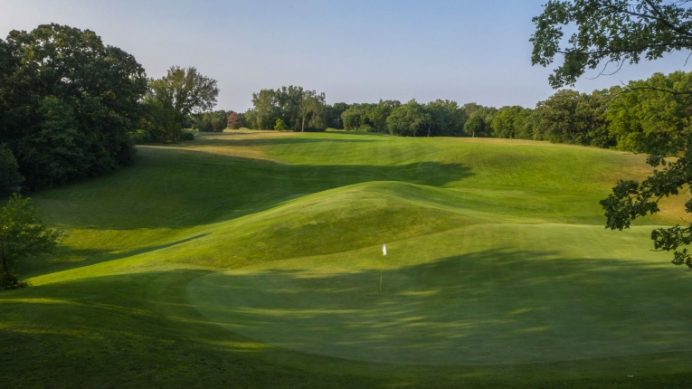
Wisconsin has some of the finest landforms in the game – and that includes the 1st hole at Eagle Springs. (photo by Patrick Koening)
1. Tell us about the Eagle Springs Golf Resort in Eagle, Wisconsin. What is its history?
Eagle Springs is the oldest course in the state of Wisconsin and the land began as a farm in 1868 by Irish immigrants, John and Mary Tuohy. Unfortunately(or fortunately) they did not have much luck farming in the new country. In 1893 John sold his portion of the land to his son, William. William did not want to farm, turning old horseshoes into signage that can still be seen around the property today. He thought that the area would be an ideal vacation spot and established a resort that included a grand hotel, 12 cottages and an 18-hole golf course.
In 1920 William’s daughter died and William decided to tear down the hotel. Some of the old hotel buildings became new cottages. The old washroom for the hotel became the clubhouse for the course. The icehouse for the hotel became the cottage that my wife’s family has rented since the 1950’s. During the Depression the 18-hole course was reduced to 9 holes and the land was sold off.
The uniqueness of the history for me is the fact that it has gone virtually untouched by trained architects and has never been renovated. It is certainly a relic where golf architecture buffs will be blown away by some of our greens that have to be seen to be believed.
When it was reduced to 9 holes, the 9 “best” holes were kept. Unfortunately, we do not have any documentation/routing of the original 18. We do have an aerial view from 1937. The fifth-generation owner, Mike Bolan, did make some adjustments to the course over the last 30 years. He added an irrigation system. He also added rail tie steps and pull cart ramps on the back of the 7th green after seeing them on courses in Ireland. He expanded the greens on #1 and #4 to allow for pin positions outside the original bowls. We are still pulling out old documents looking for more course details of the past. The original photos we find are of classic looking links with only a few trees on the course.
The course has appeared to inspire others as well. Herb Kohler and Pete Dye visited the property as they were building Whistling Straits. The hickory chairs in the clubhouse at the Straits are eerily similar to the originals in our own clubhouse.
2. So, to whom do you credit for the design of the course?
The second generation, William, hired A.G. Spalding, the former pitcher and president of the Chicago Cubs/MLB Hall of Famer/founder of Spalding Sporting Goods, who designed the first two holes and then let nature dictate the rest. William was a businessman and would bring people from Chicago up to the resort. It was a fairly prestigious group of people coming to visit the resort and 10 Chimneys, another local destination. I would love to go back in time to meet him and get more of the history. I see him as the type of guy who hands a napkin to Spalding at 2:00am and asks him to sketch a couple holes. The verbal family history has A.G. Spalding designing the first two holes but the course being built by the family. All the other work/updates to the course have been done directly by the family and executed by resort employees/volunteers. It has remained virtually untouched.
3. Please describe its famous second hole.
The second at Eagle Springs is a one-of-a-kind volcano hole of 134 yards that plays to one of the smallest targets on the course. It has to be one of the most unique and stunning holes in the country. It has been an attraction for many players, but for our aging members who had played it for years, it was becoming difficult to play. Around the turn of the century an alternate second hole was built, a downhill par 3 about the same distance. It is in the woods parallel to the original 2nd hole. Most people don’t even realize it is there. When we play leagues, the players check in and there is a sign saying either “old 2” or “new 2.” One older member says it is either Tuohy Day (2a) or Shakespeare Day (2b).
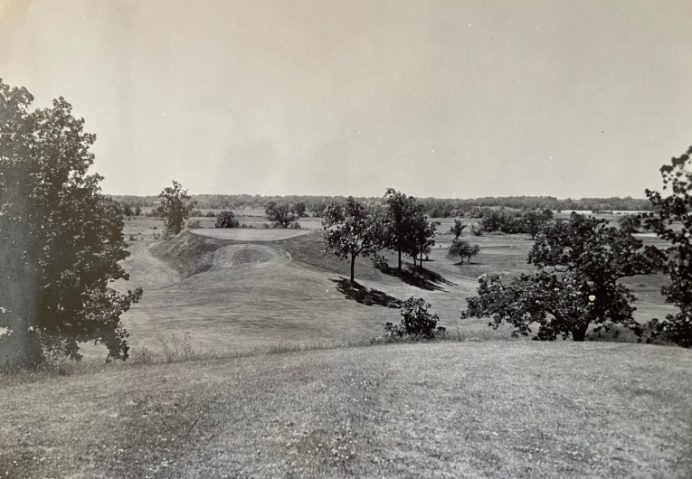
The famous 2nd in the 1930s.

The 2nd today – a volcano hole if ever there was one! (photo by Patrick Koening)
4. The second gobbles up so much attention. Please describe two other favorite holes that maybe people haven’t heard of.
The 4th is probably my favorite hole on the course. I think you could drop #4 on any course and it could pass the test. At 401 yards, it is an uphill tee shot with a blind second into what used to be a bowl green but was expanded to include a shelf. You can run up a shot and have it funnel down from the right. Left and short goes straight into a ravine that some people call “the pit of despair”.

As seen from the right, the fabulous 4th green complex which is fronted by the Pit of Despair.
#7 is the perfect 14-club challenge hole. It plays about 130 yards downhill and has a huge backstop of a hill that is about 20 feet high. I have hit a cut-off driver there just for fun. I have seen more aces there than anywhere else and most of them don’t land on the green, they come off the hill.
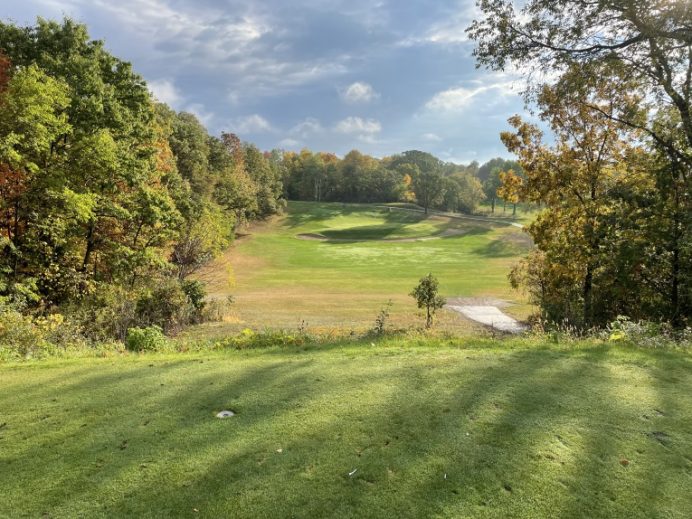
The 7th plays across a valley …
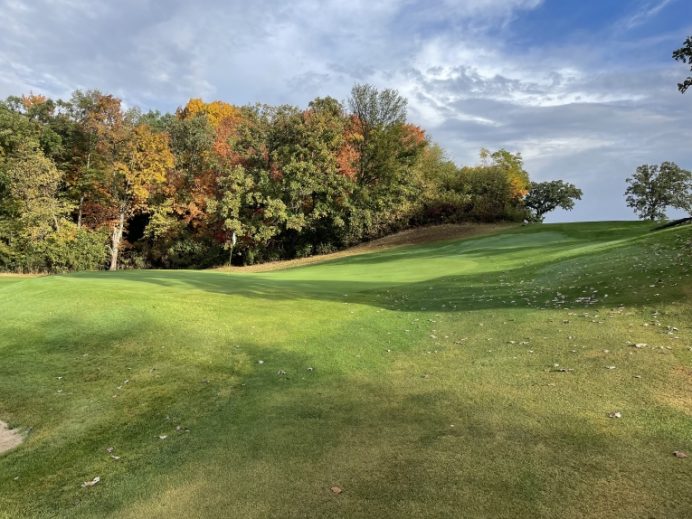
… to a green with an enormous backstop.
5. How did you and your wife, Anne, come to be the owners of Eagle Springs?
My wife Anne’s family has been renting a cottage at the resort for over 50 years. Anne’s uncle, Howard, married Mike Bolan’s sister, Morna. Many of my wife’s family memories involve Eagle Springs with two of her family members getting married on property. I loved the place the first time I set foot on it. We would take our dog with us on the course, a speaker, and play in sandals or bare feet. The tree growing in the clubhouse, the quirky greens and the laid-back nature of the place had me hooked right away. Anne and I were engaged on the property and had the rehearsal dinner for our wedding there as well.
I started taking golf and baseball clients there when the opportunity presented itself. Anne’s family joked I would have an office there one day. Three years ago, Mike approached us to let us know that none of his children were at a point to take it over and he was wondering if we would be interested. In 2020 Anne agreed to help out and learn the business to see if we had a chance to make it work. Late last year we decided to give it a shot and officially took over in February, 2021. This marks the 6th generation of family ownership and the first time the ownership left the blood line.
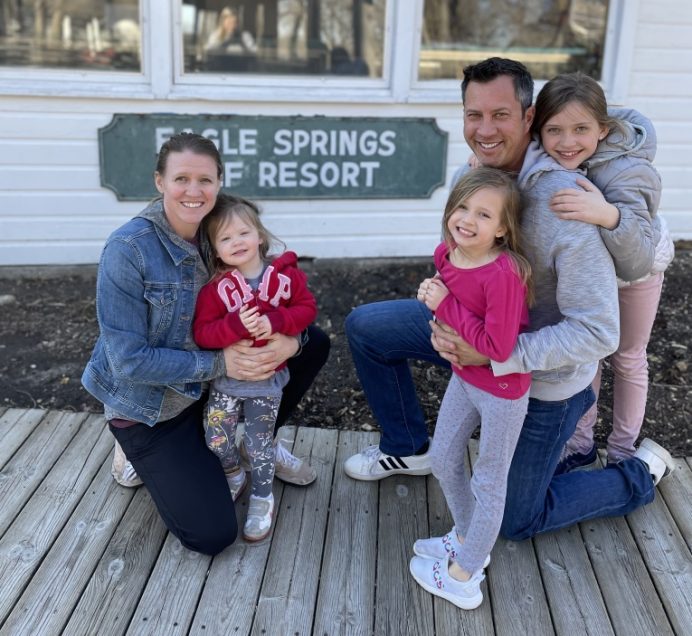
Eagle Springs is a family business.
6. What is the current business climate for Eagle Springs? What did Covid mean? What challenges do you face?
The climate is good. Covid meant a shut down right at the time that Anne was looking to get a sense of the business. Once the restrictions were lifted, Eagle Springs saw the same bounce that the industry enjoyed. The attraction of 9-hole courses is increasing, in my opinion. I think new golfers want a relaxed place to play 9 holes and learn the game.
Our immediate challenges are updating buildings (we finally got a new roof on both the barn and the clubhouse, both were leaking), updating equipment and creating a business model that honors the members and leagues that have supported the property in the past, but still generates enough revenue to make it a viable business.
7. Is there a particular day that stands out since you bought it?
I am not there every day so there are probably a number of great days that I missed, but here is one that stands out for me. We had a group from Chicago in the middle of summer who booked 4 or 5 tee times in the morning on their way to Sand Valley. Our normal members went out before them, the 8 or so blue collar/retired guys who play every day and have for years. A foursome of Hispanic players walked up and got the tee time before the Chicago group. I had not met them before, so I went out on the course after they went out and asked how they found the place. They said “we come here three to four times a year, every year, because this place was built by immigrants like us.” Then I checked in with the Chicago group before heading back to the clubhouse. In the clubhouse I found a group of 12 people who found an article on the change of ownership and were members of local private clubs. They wanted to see if there was really a tree coming out of the ground in the clubhouse and check out the bar and tables from the original hotel.
As I got in my car in the parking lot, someone stopped me who likes architecture and had a bunch of questions about the #2 green and the second hole in general. On my drive into work, I thought about the diversity of reasons people played the course that day and how it impacts all of golf in the future. The game is changing, the people who play the game are changing. I love the fact that people are now spending more time on the history and architecture of this great game. It is a tremendous responsibility for all who are in golf to educate and provide an enjoyable experience for the next generation so it continues to thrive.
While I was aware of this responsibility, I think it hit me even more that day.
8. Talk about your future plans for Eagle Springs.
Much of the answer to this question depends on what we are allowed to do by the local municipalities/governing bodies. We will learn more about any limitations in the next few years as we apply for permits. The 30,000-foot view is as follows: (1) keep the golf course experience affordable for the members/league participants that have supported the course for decades, (2) spend five years updating infrastructure (cottages, maintenance shed, equipment, etc.), (3) create short term lodging on property as soon as possible to allow for those coming from a distance to stay and play.
There are no plans to change the course soon, but we are looking to make changes to the background support. That support would include roles with maintenance and we will be looking for people who can work for 1-2 year rotations on the maintenance staff. The perfect person would have some experience and be willing to take a larger role at a smaller location to build their experience and resume.
I also look forward to continuing to use the course as an office and place to do my performance psychology work. I have sport/business clients come up to the course all year. We are looking to step this part of the business up in September when leagues are completed. Once those leagues are done and the course is more open, it allows us the chance to use the course for special groups/events for an entire day.
In the future, we will have college teams, executive groups and others coming in for both psychology performance work and a little fun on the course.
9. What are your thoughts on 9-hole courses v. 18-hole courses? Do you see specific benefits to ‘just’ being 9 holes?
I really like and appreciate this question. When I first saw Eagle Springs, I would have told you I would never want it because it was just nine holes (actually, it is 10 holes). I now think our fast-paced world prefers a quick 9 holes for many consumers, especially those new to the game. They can come in to play 9 holes and not eat up the rest of their day. It also allows for more junior play. If we want the next generation to get into the game and enjoy their time, a 9-hole option is a perfect way to step into the game.
For those who prefer spending an entire day on the game, they like to play us and then hop in their car to play 18 at Erin Hills or Kohler or Lawsonia. So, I think the consumer is more open to 9 holes now than 10 or 15 years ago.
I also see some benefits from a business perspective – wear and tear on equipment and irrigation systems is much less. We don’t have to have a full restaurant, which is expensive.
10. People hit the ball farther and farther. Do you feel like you have to keep up with technology? If so, how do you do so without ruining the unique charm that comes from playing a 125-year-old design?
No. I actually enjoy the hickory groups and people who come to Eagle Springs playing persimmon. Those groups are growing and Eagle Springs is a perfect place for them. I will also say that the increase in technology seems to be extremely popular on drivable par 4’s. Eagle Springs has 2 drivable par 4’s for a really good player. You add a shorter par 5 and it is not inconceivable for a good player to have 3 eagle putts in 9 holes. People tend to like that.
FYI … it would still be a risk/reward for those players as our greens are small enough and have enough slope that they provide a provocative challenge to good players. While the better player can have that experience, the younger/less experienced players can still play alongside and have a “normal” par 4 experience. The fact that we have never changed for technology allows for that flexibility. Playing our place is like going back in time and I don’t want to change that because of technology. I think the changes in technology allow for more flexibility and enjoyment for a variety of people with the “throwback” experience at Eagle Springs.
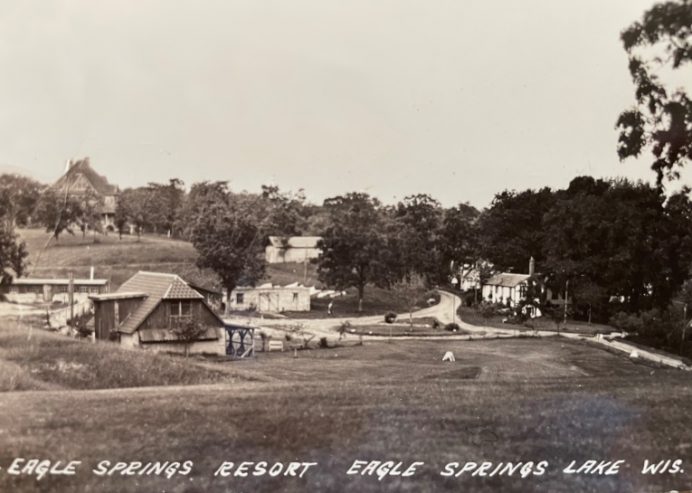
11. Tell us about your involvement with golf club manufacturers.
My expertise for the last 20 years has been psychological assessment, selection of amateur athletes based on psychological variables and creation of development plans to maximize performance based on psychological assessment. I have travelled the world for 20 years collecting data and researching the variables that correlate with performance over time. For the last five years, I have worked with a specific golf club manufacturer. We started by creating a psychological profile of their highest performers and then started selecting amateurs with similar profiles. I am very happy with the success of that partnership. They have received information on who will transition successfully to professional golf and made good choices on sponsoring those athletes.
In turn, I have been given some clients that went on to win major championships. Last year I even dove into the college team ranks and was fortunate enough to support a team that earned an NCAA national championship. In the future, instead of me travelling, our barn will turn from a maintenance facility to a psychological lab. Players and teams can come up for the day, rent out the course and I can do my work at Eagle Springs.
12. Very cool! What are the cutting-edge sports psychology concepts that are being focused on with PGA tour players?
The cutting-edge concept is matching the individual brain to the appropriate mental skill (visualization, self-talk, etc.). There are roughly 25 psychological variables that correlate with performance. These variables create a profile of high performers but no profile is “perfect.” What I have found over time is that certain profiles respond to certain inventions. For example, a profile that is strong but is low in concentration can benefit from a strong pre-shot routine. A profile that is strong in self-criticism does well in college but needs to manage self-talk once the player turns professional. The average golfer spends a good amount of money individualizing the right drill for their swing and club/ball combination for their game. For the life of me, I don’t understand why they just randomly pick up a book or ask an untrained person what mental skill they should use when they should know the mind is the most important part of the game.
13. Is there one particular tip or concept in the area of sports psychology that would you share with the average golfer who is about to play a dream round at a big-time course like Whistling Straits, Erin Hills, or Sand Valley? Trying not to let nerves compromise your performance is something to which we can all relate.
Manage expectations. The fact that golf is the only sport that televises when players are playing their best or high-quality shots while most poor shots never make it to the coverage has skewed how the amateur golfer looks at their own game. We think it is played at a high level consistently and apply that standard to ourselves.
What do you want to get out of your dream round? The longer I have done my work, the more I have realized that most people don’t have clear goals/expectations when they put the peg in the ground. If your goal is enjoyment, then play the appropriate tees and know that you will hit some bad shots. You will more than likely leave the course with a handful of shots that you really enjoyed. If your goal is to challenge yourself and see how good your game is then don’t complain if you hit a bunch of bad shots.
14. How does sports psychology intertwine with proper course management as you tack around the course?
It is possible to be overconfident in your course management. Course management to me starts with the self-awareness of your game. I made a mistake one day at Eagle Springs and put the 9th pin on the edge front left for the night of our most popular league. If you miss the front left you can legitimately roll off the green, down the slope, onto the cart path, and into the parking lot. I speak from experience. We got more complaints that night than any other night all year. I looked at the scores the next morning. About 65 percent of the league members shot within one standard deviation of their handicap. The “old” guys played just fine, with a good percentage of them actually playing their best round of the year. They would not even look at the tough pins. They just hit the middle of the green and two putted.
Meanwhile, our overconfident “adrenaline” junkies were the biggest complainers. The same guys who love to come in and brag about the shot they pulled off on other nights were complaining about the pin location that night. When it comes to course management, check your confidence at the door and be honest about your game. If you do, you have a better chance of leaving the course with a score that represents your ability.
15. Give us your thoughts on last month’s Ryder Cup at Whistling Straits.
I loved the emotion. I loved Rory’s interview. In a world where we are so focused on individual needs, the Ryder Cup provides us a chance to watch players who normally play an individual sport have a team competition and focus on group needs. No individual equipment manufacturer logos and no individual shoe manufacturer logos on the uniforms. Sometimes even no hats. There is such a different human response to something when you “have” to do something for yourself versus when you “get” to do it on a team. I left the Ryder Cup thinking that, for both sides, the passion for the game and the desire to improve in Rome will be strong. The attraction of being part of a team and working for something more than yourself clearly kindles the love of the game.
You can measure psychological traits to create profiles of performance and also as a predictive model to see if a particular profile fits a specific situation. As mentioned earlier, we have created a profile for a high performing golfer based on how he/she performs on TOUR. But the Ryder Cup is different. It comes with a team component and different energy/distractions. While many of the psychological skills will be similar, I was curious if the profile for Ryder Cup performers might be different that the profile for the TOUR performers. Please note I do have some data from the Ryder Cup players in the database, but not all or enough to be purely scientific. Much of this observation. So, as you now read along, think of European players who you think may express the psychological variables I will discuss in the following paragraphs. At the end of this section, I will suggest two players who might possess the psychological variables discussed below. No looking ahead!
There are three psychological variables I was curious about as to the impact during the Ryder Cup. Those variables are (1) introversion/extroversion (not bimodal, people can have both qualities…but that is unique). For those not familiar with the terms, introverts get their energy by being by themselves and extroverts get their energy by being around others, (2) the ability to concentrate/control distractions and (3) how those variables “fit” the Ryder Cup environment. Psychology has a concept called “goodness of fit.” Forget the first two words and just think of fit. In essence the concept suggests that to get the best performance out of situations the psychological factors have to complement each other. It was first seen in parents and children but had been applied to sport.
Here are two examples of how fit is applied. First, most team sport individuals tend to be extroverts, most individual sport athletes tend to be introverts. Second, it can be seen in player and team relationships. The best example of this is Phil Jackson, who had a “laisse faire” (laid back) coaching style. This style works well when there is one alpha dog that leads a group from the player perspective. Alpha dog players tend to have conflict with alpha dog coaches.
Let’s look at introversion/extroversion first. A wise man once told me that willing followers are just as important as strong leadership. These followers want to be part of a group, benefit from being around others and like serving a purpose greater than themselves. Those people tend to be extroverts and break the mold from the TOUR psychological performance profile. I think that those who perform better at the Ryder Cup have more extroversion than the average TOUR high performer.
Now let’s look at the ability to control distractions/concentration. The question I always get from other athletes about golfers is “why do they need it to be totally quiet when I have to perform with 60,000 people streaming at the top of their lungs.” It’s a great question. Not sure how this whole let’s be quiet thing started. Maybe the first golfers had a terrible time concentrating (and hated being around people) so they had to go in a field with no one else around just so they could hit the feathery. Would love to go back and give a psychological assessment to those guys to find how this developed. As it applies to the Ryder Cup, the atmosphere lends itself to more distractions. While the gallery may be quiet at address, the distractions up to and after address are increased. I think that the performers at the Ryder Cup would have higher distraction control/concentration skills.
Thus, I think the combination of increased extroversion and higher distraction control/concentration skills helps the normal TOUR profile fit into the RC environment. Would love to fully test out that hypothesis someday! Until we have that data…are there two Europeans that you think express the psychological variables in the above? In my mind, the man who has not lost in singles play (Poulter, 6-0-1) and the all-time points leader (Garcia, 25 points) are two examples of players who may have those variables. Maybe someday I will get a chance to talk to them and find out.
16. You moved to Wisconsin this century and have witnessed an incredible explosion of high-quality golf across the state, from excellent restorations at high-end private clubs to the creation of brand-new resorts. Is there any accounting for what awoke the sleeping giant?!
When I first moved back to Wisconsin, I worked at Whistling Straits. I heard stories of Mr. Kohler mortgaging the future to build the courses up near Kohler and most people thought he was crazy. Wisconsin is an outstanding place to be in the summer and the fall. Much of what used to be farmland came up for sale at a reasonable price and you had forward thinking people believe this could be a destination for people who love the game. Eagle Springs and Erin Hills were both once farmland. It also helps that you can drink beer while golfing ☺, because we like that too.
17. We have all heard of the state’s famous courses, from Milwaukee CC to Blue Mound to Lawsonia, on and on. What are three hidden gems that might not be on people’s radar?
- Apostle Highlands GC in Bayfield is a 1991 design with panoramic views over Lake Superior.
- Peninsula State Park Golf Course, established in 1917 on Eagle Harbor north of Green Bay, is another course with water views plus elevation changes.
- Plum Lake Golf Club, a fellow 9-holer, is a 1912 old-school design in the pines in Sayner, about 15 miles from the Upper Peninsula border of Michigan.
18. As a golf course owner in Wisconsin, does the opening of new courses, like preview rounds of Lido in 2022, put a smile on your face as it means all the more people will be coming to your state? What else would be good for your business?
It absolutely brings a smile to my face. As I have already said, we really need short term lodging for our business at Eagle Springs. We would love to be the appetizer or dessert for those taking a trip to play the main courses of Sand Valley, Erin Hill, Whistling Straits, and someday the Lido. Lodging would help with that process.
19. Tell us a bit about your work with the Milwaukee Brewers baseball club. A lot of pro baseball players are excellent golfers – is that to be expected?
I have enjoyed the honor of serving as the Brewers’ team psychologist since 2010. Currently my role is focused on the mental health and performance psychology work with our major league team. Over time that role has been reduced to allow for more work in golf. I am at every home game and half of spring training. My day is full of player meetings, helping with off-field issues, coaching meetings where we establish philosophy and messaging to the players, and player meetings on improving performance mindset. In the past, I worked in player selection and player development in addition to the work with the major league team. In those days I would visit all of the minor league affiliates, including the Dominican Republic.
Regarding baseball players as golfers, I think it is to be expected. The more downtime there is in a sport, the more “mental” that sport tends to be. There is correlation between the mindset of pitchers and golfers. They control the pace, there is downtime between events, routines are important, etc. I think it is to be expected.
Starting pitchers have good body control, hand/eye coordination and core strength. They can work their way around a golf course similar to the way they work a game plan against a team. There are a lot of parallels.








